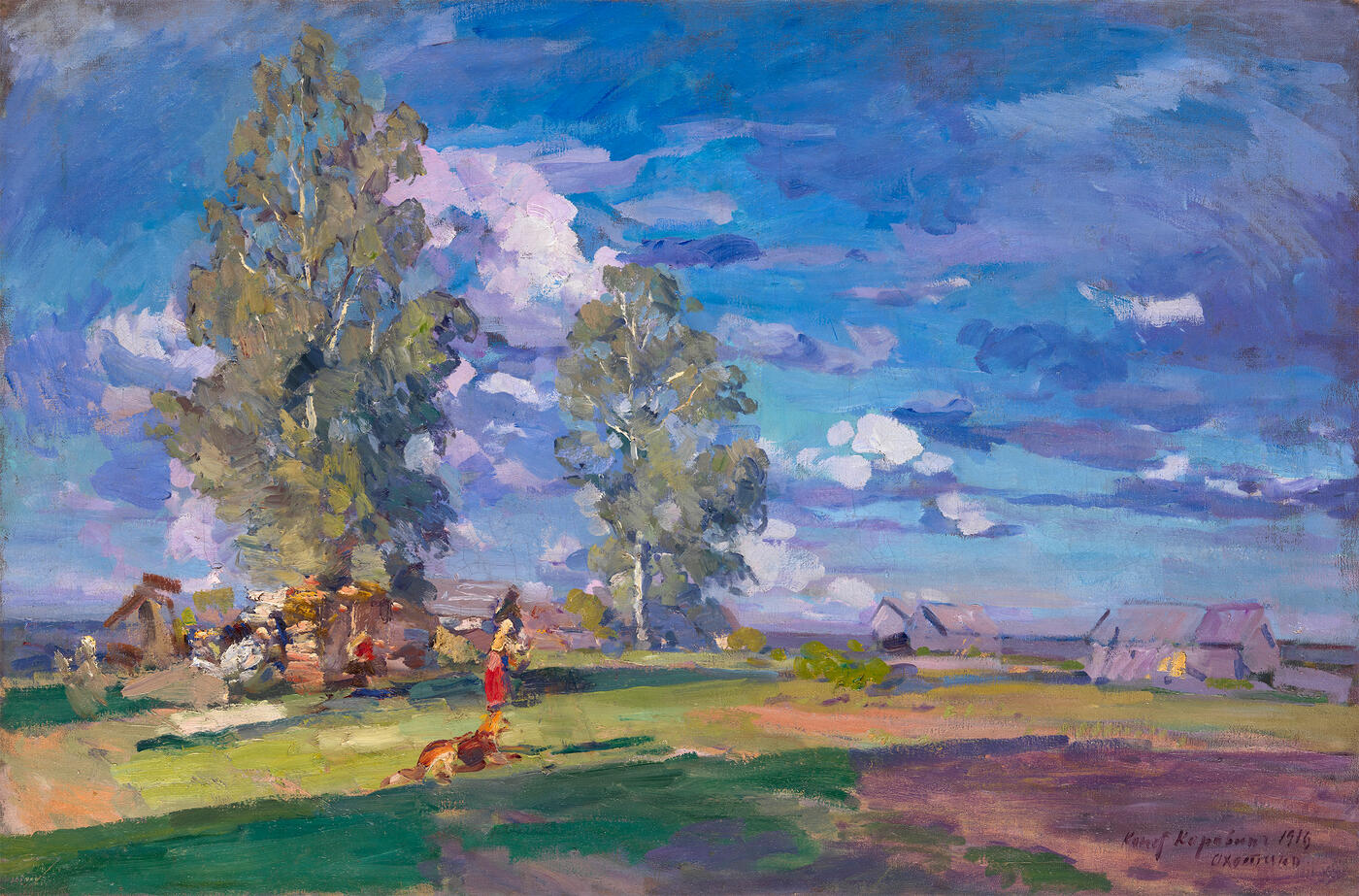5 June 2013 Russian Art Auctions
5 June 2013

78. KOROVIN, KONSTANTIN (1861-1939)
Summer Morning. Okhotino, signed, inscribed in Cyrillic "Okhotino" and dated 1916.
Oil on canvas, 87.5 by 134 cm.
600,000–800,000 GBP
Provenance: Collection of Colonel Josef Košek (1886–1953), member of the Diplomatic Corps of Czechoslovakia and First Consul of Czechoslovakia in Riga, from 1921.
Acquired from the above by the present owner.
Private collection, Germany.
Authenticity of the work has been confirmed by the expert V. Petrov.
Konstantin Korovin’s life-affirming landscape, Summer Morning. Okhotino, belongs to the remarkable cycle painted at the artist’s beloved country estate in the 1910s.
Korovin acquired the Okhotino estate from Savva Mamontov in 1897 and designed and built a small house there (which is now near Pereslavl-Zalessky). From then on he tried to spend as much time as he could there, to escape the noise of Moscow, the scenery workshops of the Bolshoi Theatre and the stuffy classrooms of the College
of Painting, Sculpture and Architecture where he taught. The full-blooded loveliness of the Vladimir countryside with its lush green woodlands, the deep dark-blue River Nerl, with its fluffy blanket of snow in winter and babbling thaw-holes, was extraordinarily dear to his heart. Korovin painted many canvasses of the Okhotino landscape, capturing familiar sights like the long lines of high trees and typical Okhotino houses with pointed finials to their sloping roofs. It is as though Okhotino nourished Korovin with its vital energy, the warmth of its sunny days, the splendour of its autumn colours, the cordiality of its winter evenings and the simplicity of peasant life. Okhotino canvasses such as Summer Morning, even more remarkable for their virtuoso painterly artistry, are essentially plein air studies elevated to the status of fully finished pictures. He painted them astonishingly quickly, sometimes out fishing or shooting – while waiting for a bite or between drives. Accordingly, nature comes across in these paintings as a concentrated sensation infused with the painter’s poetic sentiment and seemingly living and breathing the same air that he does. The same old woods, barns, wattle fences, weirs and stretches of water not only fail to tire Korovin’s eye but, on the contrary, take on a sharper individual resonance on each occasion, with the season and time of day. No wonder his peers, on seeing these unpretentious views of the Vladimir region, observed that “Korovin saw the same life as others do, but saw it in astonishing richness”.
As early as the 1870s, when he was seeking landscape motifs that were “close to my heart and which resonate with my soul” and distancing himself from the Itinerant position, Korovin wrote: “What is needed is light – more gladness, more brightness”. The strongest embodiment of these words, which became a kind of creative
credo for the artist, is in the Okhotino canvasses, in which, captivated by the natural force that is colour, becomes a true bard of the Russian summer.
Warm summer days and evenings, few in number and therefore especially gladdening to the Russian soul, dazzled Korovin with their riot of shimmering colours. In Summer Morning, dated 1916, it seems that the sun itself – rising above the horizon outside the picture and casting strips of shade on the sparse verdure of the countryside – is urging the artist to reproduce the effects of light. There are wooden houses everywhere in the distance, there are barns and stacks of wood; among the trees a peasant girl in a red dress hurries about her business and, the artist’s hunting dog waits on the road for his master to finish, wipe off his palette and pack up his easel. These tokens of the rustic genre seem to blend with the surrounding landscape in shimmering light and a multiplicity of reflections, into a single joyous symphony of colour.
It is also significant that Korovin uses his trademark chromatic discovery of 1886: the burning of red against green, which gradually takes hold in his traditional palette and the many and varied combinations of dark green and ochre tones. Running through the morning light of summer, the contrasts of hue and swiftness of his brushwork, is his intoxication with the luxuriance of painting and, through painting – the luxuriance of nature. The style of painting in which the artist applies a succession of precise, impetuous, broad brushstrokes appears relaxed. This imparts to the whole composition not only a slightly uplifted, festive mood, but also a special cadence. It seems that the artist has seized the moment and then, from behind the treetops, the sun comes out, clouds scud across the sky and the earth begins to shine in the light of summer.
Thus, these landscapes of the first and second decades of the 20th century occupy a special place in Korovin’s creative legacy. Preserving the immediacy and vivacity of an impression and the astonishing painterly bravura that distinguishes Korovin’s best pieces, they have become perhaps more profound and poignant than anything
else that the artist bequeathed to posterity.
Notes on symbols:
* Indicates 5% Import Duty Charge applies.
Ω Indicates 20% Import Duty Charge applies.
§ Indicates Artist's Resale Right applies.
† Indicates Standard VAT scheme applies, and the rate of 20% VAT will be charged on both hammer price and premium.